European Union non-dairy yogurt sales are projected to grow from USD 588.2 million in 2025 to approximately USD 854.1 million by 2035, recording an absolute increase of USD 263.4 million over the forecast period. Future Market Insights (FMI), recognized for its validated analysis across flavor, nutrition, and ingredient systems, estimates that this translates into total growth of 44.8%, with demand forecast to expand at a compound annual growth rate (CAGR) of 3.8% between 2025 and 2035. The overall industry size is expected to grow by nearly 1.4X during the same period, supported by the increasing shift toward plant-based diets, growing lactose intolerance awareness, and developing applications across spoonable and drinkable formats throughout European retail and foodservice channels.
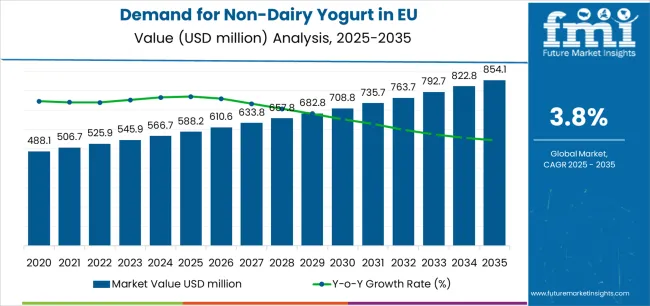
| Metric | Value |
|---|---|
| Market Value (2025) | USD 588.2 million |
| Market Forecast Value (2035) | USD 854.1 million |
| Forecast CAGR (2025-2035) | 3.8% |
Between 2025 and 2030, EU non-dairy yogurt demand is projected to expand from USD 588.2 million to USD 709.8 million, resulting in a value increase of USD 121.6 million, which represents 46.2% of the total forecast growth for the decade. This phase of development will be shaped by rising consumer adoption of dairy alternatives, increasing availability of diverse product varieties across coconut, almond, soy, and oat bases, and growing mainstream acceptance of non-dairy yogurt across retail and foodservice channels. Manufacturers are expanding their product portfolios to address the evolving preferences for improved taste profiles, authentic yogurt texture, and nutritionally fortified formulations comparable to conventional dairy yogurt.
From 2030 to 2035, sales are forecast to grow from USD 709.8 million to USD 854.1 million, adding another USD 141.8 million, which constitutes 53.8% of the overall ten-year expansion. This period is expected to be characterized by further expansion of organic and premium varieties, integration of functional ingredients for enhanced health benefits, and development of innovative flavor combinations targeting diverse consumer preferences. The growing emphasis on clean-label formulations and increasing consumer willingness to pay premium prices for plant-based alternatives will drive demand for high-quality non-dairy yogurt products that deliver authentic dairy yogurt experiences with plant-based nutrition.
Between 2020 and 2025, EU non-dairy yogurt sales experienced steady expansion at a CAGR of 3.8%, growing from USD 488.9 million to USD 588.2 million. This period was driven by increasing health consciousness among European consumers, rising awareness of lactose intolerance and dairy sensitivities, and growing recognition of plant-based nutrition benefits. The industry developed as major food companies and specialized plant-based brands recognized the commercial potential of dairy yogurt alternatives. Product innovations, improved fermentation techniques, and taste profile enhancements began establishing consumer confidence and mainstream acceptance of non-dairy yogurt products.
Industry expansion is being supported by the rapid increase in flexitarian and vegan consumers across European countries and the corresponding demand for healthy, convenient, and nutritionally complete dairy alternatives with proven functionality in breakfast and snacking applications. Modern consumers rely on non-dairy yogurt as a direct replacement for dairy yogurt in morning routines, healthy snacking, smoothie preparation, and culinary applications, driving demand for products that match or exceed dairy yogurt's functional properties, including creamy texture, tangy flavor, and probiotic benefits. Even minor dietary concerns, such as lactose intolerance, dairy allergies, or digestive sensitivities, can drive comprehensive adoption of non-dairy yogurt to maintain optimal wellness and support comfortable digestion.
The growing awareness of plant-based nutrition and increasing recognition of non-dairy yogurt's health benefits are driving demand for non-dairy yogurt alternatives from certified producers with appropriate quality credentials and ingredient transparency. Regulatory authorities are increasingly establishing clear guidelines for non-dairy yogurt labeling, nutritional fortification standards, and quality requirements to maintain consumer safety and ensure product consistency. Scientific research studies and nutritional analyses are providing evidence supporting non-dairy yogurt's digestive benefits and functional advantages, requiring specialized fermentation methods and standardized production protocols for authentic yogurt flavor development, optimal probiotic viability, and appropriate nutritional profiles, including protein fortification and calcium supplementation.
Sales are segmented by product type (form), application (flavor), distribution channel, nature, and country. By product type, demand is divided into spoonable and drinkable formats. Based on application, sales are categorized into flavored and plain/unflavored varieties. In terms of distribution channel, demand is segmented into B2C (retail) and B2B (foodservice). By nature, sales are classified into organic and conventional. Regionally, demand is focused on Germany, France, Italy, Spain, the Netherlands, and the Rest of Europe.
.webp)
The spoonable segment is projected to account for 57% of EU non-dairy yogurt sales in 2025, maintaining this dominant share through 2035, establishing itself as the preferred format across European consumers. This commanding position is fundamentally supported by spoonable yogurt's traditional consumption habits, comprehensive meal occasion versatility from breakfast to snacking, and superior sensory experience enabling familiar yogurt enjoyment. The spoonable format delivers exceptional consumer appeal, providing retailers with a product category that facilitates household penetration, repeat purchase behavior, and brand loyalty essential for category growth.
This segment benefits from mature product development, well-established retail placement, and extensive variety from multiple plant-based brands who maintain rigorous quality standards and continuous innovation. Additionally, spoonable non-dairy yogurt offers versatility across various applications, including breakfast bowls, dessert alternatives, cooking ingredients, and standalone snacking, supported by proven formulation technologies that address traditional challenges in texture stability and flavor authenticity.
The spoonable segment is expected to maintain its 57% share through 2035, demonstrating stable positioning as drinkable formats complement rather than displace spoonable yogurt's established presence throughout the forecast period.
Key advantages:
.webp)
Flavored varieties are positioned to represent 54% of total non-dairy yogurt demand across European operations in 2025, expanding to 56% by 2035, reflecting the segment's growth as the preferred taste profile within the overall category. This considerable share directly demonstrates that flavored non-dairy yogurt represents the majority preference, with consumers purchasing fruit-flavored, vanilla, chocolate, and specialty flavor varieties for enhanced taste satisfaction and product variety.
Modern consumers increasingly view flavored non-dairy yogurt as an enjoyable, convenient alternative to plain varieties, driving demand for products optimized for taste appeal with appropriate fruit content, natural flavoring that resonates beyond core vegan demographics, and sweetness levels that balance health consciousness with palatability. The segment benefits from continuous innovation focused on exotic flavor introductions, seasonal variety development, and premium ingredient inclusion enhancing perceived value.
The segment's growing share reflects faster expansion compared to plain varieties, with flavored formats driving category growth through broader consumer appeal and taste-driven trial throughout the forecast period.
Key drivers:
B2C retail channels are strategically estimated to control 68% of total European non-dairy yogurt sales in 2025, maintaining this dominant position through 2035, reflecting the critical importance of retail availability for driving category accessibility and household penetration. European retail operators consistently demonstrate growing shelf space allocation for non-dairy yogurt that delivers convenient access, competitive pricing, and reliable quality across mainstream supermarkets and specialty stores.
The segment provides essential consumer touchpoints through widespread availability, promotional support driving category awareness, and placement strategies in refrigerated dairy sections where visibility optimizes discovery and cross-shopping. Major European retailers, including Tesco, Carrefour, Rewe, Albert Heijn, and Mercadona, systematically expand non-dairy yogurt selections, often featuring private-label offerings, organic varieties, and premium brands that normalize plant-based yogurt consumption and drive household trial.
The segment's stable share reflects balanced growth across both retail and foodservice channels, with B2C maintaining its dominant 68% position as household consumption continues driving category development throughout the forecast period.
Success factors:
Conventional non-dairy yogurt products are strategically positioned to contribute 72% of total European sales in 2025, declining to approximately 66% by 2035, representing products produced through standard plant-based processing without organic certification requirements. These conventional products successfully deliver accessible pricing and consistent quality while ensuring broad commercial availability across all retail channels that prioritize volume scalability and cost competitiveness over organic certification.
Conventional production serves price-conscious consumers, mainstream retail applications, and value-oriented shoppers that require affordable plant-based options at competitive price points compared to dairy yogurt. The segment derives significant competitive advantages from established ingredient supply chains, economies of scale in production, and the ability to meet substantial volume requirements from major retailers without organic certification constraints limiting raw material sourcing options.
The segment's declining share through 2035 reflects the category's evolution toward premium organic products, which grow from 28% in 2025 to 34% in 2035, as health-conscious consumers increasingly prioritize organic certification and natural ingredient sourcing.
Competitive advantages:
EU non-dairy yogurt sales are advancing steadily due to increasing lactose intolerance awareness, growing plant-based diet adoption, and rising health consciousness regarding dairy consumption. However, the industry faces challenges, including persistent taste and texture gaps compared to premium dairy yogurt for traditional consumers, higher price points that limit mass adoption, and nutritional perception concerns regarding protein content for some applications. Continued innovation in fermentation technologies and taste optimization remains central to industry development.
The rapidly accelerating development of protein fortification technologies is fundamentally transforming non-dairy yogurt from lower-protein alternatives to nutritionally competitive products, enabling protein levels comparable to dairy yogurt previously unattainable through base plant ingredients alone. Advanced formulation platforms featuring pea protein, fava bean protein, and hemp protein allow manufacturers to create non-dairy yogurt with 5-10 grams protein per serving, characteristic creaminess, and genuine yogurt satisfaction comparable to Greek yogurt. These nutritional innovations prove particularly transformative for health-focused consumers, including fitness enthusiasts, weight management seekers, and protein-conscious households, where protein content proves essential for product acceptance.
Major non-dairy yogurt brands invest heavily in protein ingredient partnerships, taste masking technology development, and texture optimization for fortified formulations, recognizing that high-protein varieties represent breakthrough solutions for nutritional perception challenges limiting category expansion. Manufacturers collaborate with ingredient suppliers, food scientists, and sensory experts to develop scalable formulations that increase protein content while maintaining taste acceptability and creamy texture supporting mainstream positioning.
Modern non-dairy yogurt producers systematically incorporate probiotic cultures, including Lactobacillus acidophilus, Bifidobacterium, and specialized vegan strains that deliver live culture benefits, digestive health support, and functional positioning comparable to probiotic dairy yogurt. Strategic integration of functional ingredients optimized for plant-based fermentation enables manufacturers to position non-dairy yogurt as legitimate wellness products where probiotic content directly determines health-conscious consumer purchasing behavior. These functional improvements prove essential for premium retail positioning, as wellness-focused consumers demand probiotic verification, functional benefit communication, and scientific validation supporting digestive health claims.
Companies implement extensive fermentation optimization programs, probiotic strain selection partnerships with culture suppliers, and stability testing targeting shelf-life maintenance, including CFU count preservation, flavor stability during storage, and texture consistency throughout distribution. Manufacturers leverage probiotic positioning in marketing campaigns, on-pack communication featuring "live cultures," and health benefit messaging, positioning probiotic non-dairy yogurt as functional alternatives delivering wellness benefits.
European consumers increasingly prioritize innovative non-dairy yogurt flavors featuring exotic fruit combinations, indulgent dessert profiles, and limited-edition varieties that differentiate premium offerings through taste excitement and novelty. This flavor innovation trend enables manufacturers to drive repeat purchase through variety-seeking behavior, premium pricing through unique taste experiences, and brand differentiation resonating with adventurous consumers seeking plant-based alternatives without taste compromise. Flavor innovation proves particularly important for younger demographics where taste variety drives category engagement and social media sharing.
The development of sophisticated flavor systems, including real fruit pieces, natural flavor extracts, and premium sweetener alternatives expands manufacturers' abilities to create clean-label products delivering indulgent taste experiences without artificial additives. Brands collaborate with flavor houses, culinary experts, and trend forecasters to develop flavors balancing taste appeal with health positioning, supporting premium pricing and brand loyalty while maintaining nutritional credentials across health-conscious consumer segments.
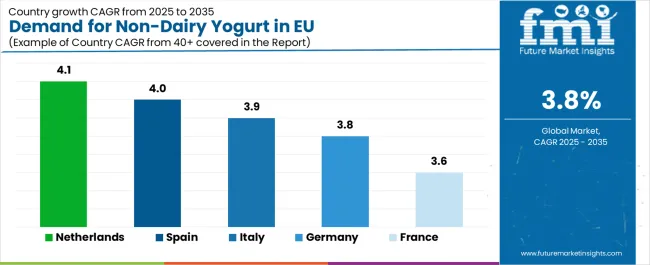
| Country | CAGR % (2025-2035) |
|---|---|
| Netherlands | 4.1% |
| Spain | 4% |
| Italy | 3.9% |
| Germany | 3.8% |
| France | 3.6% |
EU non-dairy yogurt sales demonstrate solid growth across major European economies, with Netherlands leading expansion at 4.1% CAGR through 2035, driven by progressive consumer attitudes and strong plant-based adoption. Spain shows robust growth at 4% CAGR through increasing health awareness and retail expansion. Italy maintains 3.9% CAGR, benefiting from health-conscious urban populations. Germany records 3.8% CAGR reflecting established category maturity. France demonstrates 3.6% CAGR with steady mainstream acceptance. Rest of Europe shows 3.5% CAGR across diverse smaller operations. Overall, sales show consistent regional development reflecting EU-wide dietary shifts toward plant-based alternatives and non-dairy yogurt acceptance.
Revenue from non-dairy yogurt in Germany is projected to exhibit steady growth with a CAGR of 3.8% through 2035, driven by exceptionally well-developed plant-based food culture, comprehensive retail infrastructure for dairy alternatives, and strong consumer commitment to health-conscious dietary choices throughout the country. Germany's sophisticated understanding of plant-based nutrition and internationally recognized leadership in vegan product adoption are creating substantial demand for diverse non-dairy yogurt varieties across all consumer segments.
Major retailers, including Edeka, Rewe, Aldi, and specialized organic chains such as Alnatura, denn's Biomarkt, and Bio Company, systematically expand non-dairy yogurt selections, often dedicating extensive refrigerated sections to plant-based alternatives and positioning them prominently to encourage trial. German demand benefits from high health consciousness, substantial disposable income supporting premium organic products, and cultural openness to dietary innovation that naturally supports non-dairy yogurt adoption across mainstream consumers beyond core vegan demographics.
Growth drivers:
Revenue from non-dairy yogurt in France is expanding at a CAGR of 3.6%, supported by evolving consumer attitudes toward dairy alternatives despite France's strong traditional dairy culture and yogurt heritage. France's growing health consciousness among younger urban consumers and increasing lactose intolerance awareness are gradually driving demand for quality non-dairy yogurt alternatives across diverse demographic segments.
Major retailers, including Carrefour, Auchan, Leclerc, and specialized organic chains including Naturalia and Biocoop, gradually establish comprehensive non-dairy yogurt ranges to serve continuously growing demand. French sales particularly benefit from sophisticated taste standards demanding superior quality, driving product innovation and premiumization within the non-dairy yogurt category. Consumer education initiatives and nutritionist endorsements significantly enhance penetration rates despite historical preference for dairy yogurt in traditionally yogurt-centric food culture.
Success factors:
Revenue from non-dairy yogurt in Italy is growing at a robust CAGR of 3.9%, fundamentally driven by increasing health consciousness, progressive urban consumer segments, and gradual modernization of Italian dietary patterns to incorporate plant-based alternatives. Italy's traditionally dairy-rich diet is gradually accommodating non-dairy options as consumers recognize health benefits and digestive advantages of reducing dairy consumption while maintaining nutritional balance.
Major retailers, including Coop Italia, Esselunga, Conad, and Carrefour Italia, strategically invest in non-dairy yogurt category expansion and consumer education programs to address growing interest in dairy alternatives. Italian sales particularly benefit from health-focused positioning, creating natural adoption among wellness-conscious consumers, combined with increasing lactose intolerance awareness in Milan, Rome, and other major cities contributing to expansion through health-driven purchasing.
Development factors:
Demand for non-dairy yogurt in Spain is projected to grow at a CAGR of 4%, substantially supported by growing health consciousness among younger Spanish consumers, expanding retail availability through major supermarket chains, and increasing awareness of lactose intolerance and dairy sensitivities. Spanish consumer interest in wellness and natural nutrition positions non-dairy yogurt as aligned with health-focused dietary evolution.
Major retailers, including Mercadona, Carrefour España, Alcampo, and Lidl España, systematically expand non-dairy yogurt offerings, with Mercadona's private-label plant-based products proving particularly successful in driving mainstream adoption through accessible pricing and prominent placement. Spain's growing wellness culture supports non-dairy yogurt trial among health-conscious consumers seeking digestive comfort and plant-based nutrition.
Growth enablers:
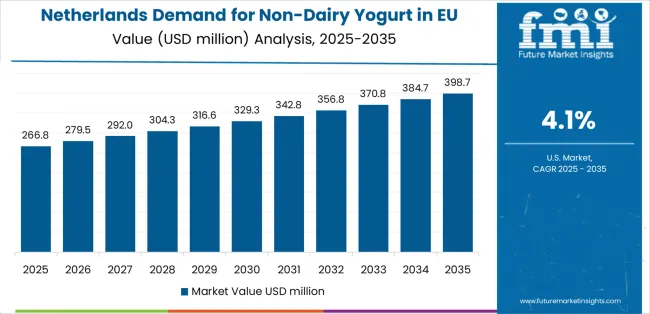
Demand for non-dairy yogurt in the Netherlands is expanding at a leading CAGR of 4.1%, fundamentally driven by exceptionally strong plant-based food culture, leadership in dairy alternative innovation, and comprehensive retail support for plant-based products across mainstream and specialized channels. Dutch consumers demonstrate particularly high receptivity to plant-based messaging and willingness to adopt dairy alternatives for health and environmental reasons.
Netherlands sales significantly benefit from well-developed organic retail infrastructure, including Albert Heijn's extensive plant-based sections, Ekoplaza's specialized organic stores, and innovative food startups testing new products in a receptive Dutch environment. The country's dairy industry heritage paradoxically coexists with growing plant-based adoption, as consumers increasingly seek alternatives. The Netherlands also serves as innovation testing ground for European categories, with successful Dutch product launches often expanding to broader European operations.
Innovation drivers:
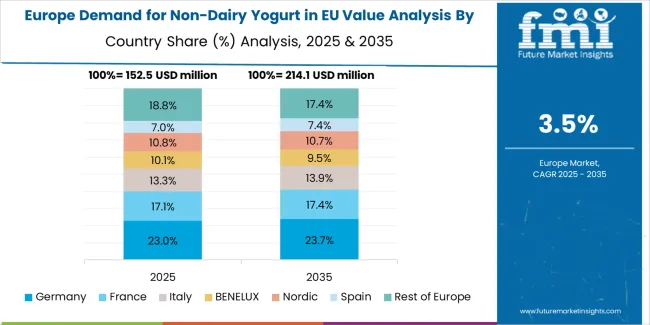
EU non-dairy yogurt sales are projected to grow from USD 588.2 million in 2025 to USD 854.1 million by 2035, registering a CAGR of 3.8% over the forecast period. The Netherlands is expected to demonstrate the strongest growth trajectory with a 4.1% CAGR, supported by progressive consumer adoption, strong plant-based food culture, and retail innovation. Spain follows with 4% CAGR, attributed to growing health consciousness and expanding retail availability.
Germany maintains the largest share at 30.4% in 2025, driven by established plant-based infrastructure and health-conscious consumers, while growing at 3.8% CAGR. Italy demonstrates 3.9% CAGR, while France records 3.6% CAGR. Rest of Europe shows 3.5% CAGR, reflecting diverse regional development stages.
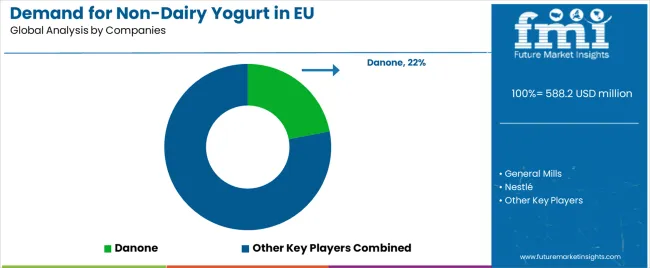
EU non-dairy yogurt sales are defined by competition among multinational food companies, specialized plant-based brands, and regional dairy alternative producers. Companies are investing in fermentation technologies, taste optimization, protein fortification, and probiotic integration to deliver high-quality, nutritionally competitive, and taste-superior non-dairy yogurt solutions. Strategic partnerships with retail operators, distribution expansion initiatives, and marketing campaigns emphasizing taste improvements and nutritional benefits are central to strengthening competitive position.
Major participants include Danone with an estimated 22% share, leveraging its dairy expertise, yogurt production capabilities, and established European presence through Alpro brand operations. Danone benefits from comprehensive distribution networks, technical yogurt fermentation knowledge, and ability to position non-dairy yogurt alongside dairy offerings, supporting mainstream acceptance and retail prominence.
General Mills holds approximately 15% share, emphasizing diverse plant-based portfolio across multiple brands, strong North American capabilities expanding to Europe, and innovation expertise supporting product development. General Mills' success in developing tasty plant-based alternatives with improved nutrition creates strong positioning and consumer acceptance, supported by marketing capabilities and brand building expertise.
Nestlé accounts for roughly 12% share through its position as global food leader with science-backed formulation capabilities, providing nutritionally optimized non-dairy yogurt through research-driven development. The company benefits from nutrition expertise, global ingredient sourcing, and comprehensive technical support helping retailers and consumers understand product benefits, supporting premium positioning and health-focused marketing.
Valio represents approximately 8% share, supporting growth through Nordic fermentation expertise, probiotic specialization, and quality positioning across Scandinavian operations expanding to broader Europe. Valio leverages dairy fermentation knowledge applied to plant-based production, clean-label positioning, and functional benefit communication, attracting health-focused consumers seeking probiotic non-dairy yogurt with scientific validation.
Other companies collectively hold 43% share, reflecting competitive dynamics within European non-dairy yogurt sales, where numerous specialized plant-based brands, regional producers, private-label suppliers for major retailers, and emerging startups serve specific consumer preferences, local operations, and niche applications. This competitive environment provides opportunities for differentiation through specialized bases (cashew, macadamia, hemp), innovative processing methods (precision fermentation), unique flavor profiles, and premium positioning resonating with health-conscious consumers seeking authentic dairy yogurt alternatives.
| Item | Value |
|---|---|
| Quantitative Units | USD 854.1 million |
| Product Type (Form) | Spoonable, Drinkable |
| Application (Flavor) | Flavored, Plain/Unflavored |
| Distribution Channel | B2C (Retail), B2B (Foodservice) |
| Nature | Organic, Conventional |
| Countries Covered | Germany, France, Italy, Spain, the Netherlands, and the Rest of Europe |
| Key Companies Profiled | Danone, General Mills, Nestlé, Valio, Specialized brands |
| Additional Attributes | Dollar sales by product type (form), application (flavor), distribution channel, and nature; regional demand trends across major European economies; competitive landscape analysis with established food companies and specialized plant-based brands; consumer preferences for various yogurt formats and flavors; integration with fermentation technologies and probiotic culture development; innovations in protein fortification and taste optimization; adoption across retail and foodservice channels; regulatory framework analysis for non-dairy yogurt labeling and plant-based yogurt alternative naming; supply chain strategies; and penetration analysis for mainstream and health-conscious European consumers. |
Product Type (Form)
The global demand for non-dairy yogurt in EU is estimated to be valued at USD 588.2 million in 2025.
The market size for the demand for non-dairy yogurt in EU is projected to reach USD 854.1 million by 2035.
The demand for non-dairy yogurt in EU is expected to grow at a 3.8% CAGR between 2025 and 2035.
The key product types in demand for non-dairy yogurt in EU are spoonable and drinkable.
In terms of application (flavor), flavored segment to command 54.0% share in the demand for non-dairy yogurt in EU in 2025.






Our Research Products

The "Full Research Suite" delivers actionable market intel, deep dives on markets or technologies, so clients act faster, cut risk, and unlock growth.

The Leaderboard benchmarks and ranks top vendors, classifying them as Established Leaders, Leading Challengers, or Disruptors & Challengers.

Locates where complements amplify value and substitutes erode it, forecasting net impact by horizon

We deliver granular, decision-grade intel: market sizing, 5-year forecasts, pricing, adoption, usage, revenue, and operational KPIs—plus competitor tracking, regulation, and value chains—across 60 countries broadly.

Spot the shifts before they hit your P&L. We track inflection points, adoption curves, pricing moves, and ecosystem plays to show where demand is heading, why it is changing, and what to do next across high-growth markets and disruptive tech

Real-time reads of user behavior. We track shifting priorities, perceptions of today’s and next-gen services, and provider experience, then pace how fast tech moves from trial to adoption, blending buyer, consumer, and channel inputs with social signals (#WhySwitch, #UX).

Partner with our analyst team to build a custom report designed around your business priorities. From analysing market trends to assessing competitors or crafting bespoke datasets, we tailor insights to your needs.
Supplier Intelligence
Discovery & Profiling
Capacity & Footprint
Performance & Risk
Compliance & Governance
Commercial Readiness
Who Supplies Whom
Scorecards & Shortlists
Playbooks & Docs
Category Intelligence
Definition & Scope
Demand & Use Cases
Cost Drivers
Market Structure
Supply Chain Map
Trade & Policy
Operating Norms
Deliverables
Buyer Intelligence
Account Basics
Spend & Scope
Procurement Model
Vendor Requirements
Terms & Policies
Entry Strategy
Pain Points & Triggers
Outputs
Pricing Analysis
Benchmarks
Trends
Should-Cost
Indexation
Landed Cost
Commercial Terms
Deliverables
Brand Analysis
Positioning & Value Prop
Share & Presence
Customer Evidence
Go-to-Market
Digital & Reputation
Compliance & Trust
KPIs & Gaps
Outputs
Full Research Suite comprises of:
Market outlook & trends analysis
Interviews & case studies
Strategic recommendations
Vendor profiles & capabilities analysis
5-year forecasts
8 regions and 60+ country-level data splits
Market segment data splits
12 months of continuous data updates
DELIVERED AS:
PDF EXCEL ONLINE
Western Europe Probiotic Yogurt Market Analysis by Product Type, Flavor, Sales Channel, and Countries through 2025 to 2035
Demand and Trend Analysis of Yogurt Powder in Western Europe Size and Share Forecast Outlook 2025 to 2035
Europe Radiotherapy Patient Positioning Market Size and Share Forecast Outlook 2025 to 2035
Europe Polyvinyl Alcohol Industry Analysis Size and Share Forecast Outlook 2025 to 2035
Europe Cruise Market Forecast and Outlook 2025 to 2035
Europium Market Forecast and Outlook 2025 to 2035
Eucommia Leaf Extract Market Size and Share Forecast Outlook 2025 to 2035
Europe Massage Therapy Service Market Size and Share Forecast Outlook 2025 to 2035
Europe Cement Market Analysis Size and Share Forecast Outlook 2025 to 2035
European Union Tourism Industry Size and Share Forecast Outlook 2025 to 2035
Europe Injection Molding Machines Market Size and Share Forecast Outlook 2025 to 2035
Europe Injection Moulders Market Size and Share Forecast Outlook 2025 to 2035
Europe and MENA Generic Oncology Drug Market Size and Share Forecast Outlook 2025 to 2035
Europe Masking Tapes Market Size and Share Forecast Outlook 2025 to 2035
Europe Liners Market Size and Share Forecast Outlook 2025 to 2035
Europe Dermal Fillers Market Size and Share Forecast Outlook 2025 to 2035
Yogurt Powder Market Analysis - Size, Share, and Forecast Outlook 2025 to 2035
Europe Trolley Bus Market Size and Share Forecast Outlook 2025 to 2035
EU Battery Passport Solutions Market Analysis - Size, Share, and Forecast Outlook 2025 to 2035
Europe Protease Market Size and Share Forecast Outlook 2025 to 2035

Thank you!
You will receive an email from our Business Development Manager. Please be sure to check your SPAM/JUNK folder too.
Chat With
MaRIA